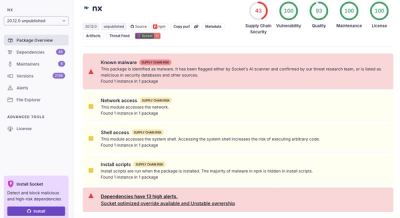
Security News
/Research
Wallet-Draining npm Package Impersonates Nodemailer to Hijack Crypto Transactions
Malicious npm package impersonates Nodemailer and drains wallets by hijacking crypto transactions across multiple blockchains.

This is the authonice backend for nodejs, mongoose & express.
authonice is a platform/language/framework agnostic ecosystem for web-app authentication, with lots of inspiration from satellizer.
It's designed to work with lots of backend languages, auth services, & frontend frameworks. It's goal is to make you super-happy because your sites are safe, easy to setup & maintain, and stylishly locked-down in your language/frameworks of choice.
If we don't have a module for the frontend-framework/backend-language/auth-service you want to support, ask us or contribute!
You can see a demo of this in-use, here
npm install authonice
var express = require('express');
var app = express();
var mongoose = require('mongoose');
mongoose.connect('mongodb://localhost/quickstart');
var authonice = require('authonice');
var Email = require('mongoose-type-email');
// Your User model with the default fields
var UserSchema = new mongoose.Schema({
email: {type: Email, required:true, unique:true},
password: {type: String, required:true},
verify: {type:String, default:null}
});
UserSchema.plugin(require('mongoose-bcrypt'));
var User = module.exports = mongoose.model('User', UserSchema);
// mount auth endpoints at /auth
app.use('/auth', authonice.middleware(User));
// lock down your secret API
app.get('/secret', authonice, function(req, res){
// you have access to req.user here
res.send('cool!');
});
// serve up whatever your frontend is
app.use(express.static('./public'));
app.listen(3000);
authonice.middleware has a second parameter that looks like this:
{
// Your secret token key.
// default: pseudo-random
secret: 'kittykat0nkeybo04rD',
// Called when a user registers. Use it to email them.
// default: console.log, so you can manually verify
verifyCallback: function(user, code){}
}
If you don't set secret, it will change on every server-reboot, so issued tokens will all be invalid.
PROTIP: Make sure that you use HTTPS, in production, on your auth endpoints, so users aren't sending their credentials plaintext.
Instead of using app.listen(3000) (HTTP) it's highly recommended that you use HTTPS. Here is how you would do that:
var fs = require('fs');
var https = require('https');
var credentials = {
key: fs.readFileSync('sslcert/server.key', 'utf8'),
cert: fs.readFileSync('sslcert/server.crt', 'utf8')
};
https.createServer(credentials, app).listen(443);
On PAAS like heroku, often you will get put behind a HTTPS proxy, so your users are safe, but it will serve both HTTP & HTTPS. You can help users to use HTTPS on your whole site, by putting this before all other app stuff:
app.get('*', function(req,res,next){
if(req.headers['x-forwarded-proto']!='https'){
res.redirect('https://mypreferreddomain.com'+req.url);
}else{
next();
}
});
If you mounted your endpoint at /auth (above) you will get these REST endpoints:
POST /auth/login - login with vars email & password, receive an auth tokenPOST /auth/register - register a new user, send verification emailGET /auth/verify/:code - verify a user, based on an email they receivedPOST /auth/resend - resend verification email (requires email in vars)GET /auth/user (LOCKED) - send user objectGET /auth/token (LOCKED) - fast token-check, sends OKAll the frontends should support these, once you tell them the endpoint (in the above examples, /auth)
FAQs
authnice backend for nodejs, mongoose & express
We found that authonice demonstrated a not healthy version release cadence and project activity because the last version was released a year ago. It has 1 open source maintainer collaborating on the project.
Did you know?

Socket for GitHub automatically highlights issues in each pull request and monitors the health of all your open source dependencies. Discover the contents of your packages and block harmful activity before you install or update your dependencies.

Security News
/Research
Malicious npm package impersonates Nodemailer and drains wallets by hijacking crypto transactions across multiple blockchains.

Security News
This episode explores the hard problem of reachability analysis, from static analysis limits to handling dynamic languages and massive dependency trees.

Security News
/Research
Malicious Nx npm versions stole secrets and wallet info using AI CLI tools; Socket’s AI scanner detected the supply chain attack and flagged the malware.